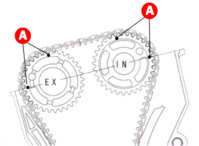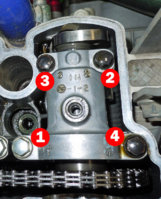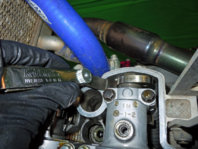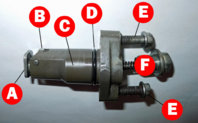James
Staff member
So you checked your valve clearances and one or more valves are out of spec. And I'm guessing that you're thinking "What the heck do I do now?" Don't worry this should give you an idea on what to do.
Since we're starting right where we left off in Part 1, the engine should already be TDC and the cams exposed, if not please read Part 1 first. (Click Here to see Part 1 - Checking Valve Clearances)
Recommended Valve Clearance:
Tools Needed:
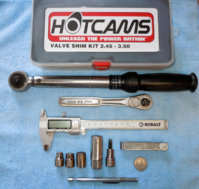
Just to clarify, the below items should already be done (if not refer to Part 1):
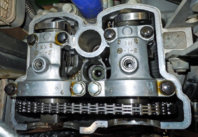
Shown with valve cover off, spark-plug removed, and set to TDC.
Ok now to the "adjusting" part, the first thing I always do is put a ratchet/breaker-bar onto the crankshaft (through the bottom timing hole) and after making sure it's still TDC, zip -tie it to the frame. (See image below) This can save headaches down the road.
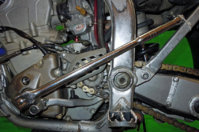
Next, using a permanent marker, put a mark across your cam chain and sprocket (use a rag to wipe the oil off before you mark it). This makes the re-install go a lot quicker, all you have to do now is lineup the marks and the engine is correctly timed. (See image below)
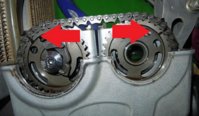
After that's done you'll have to remove the cam chain tensioner (see image below), this will relieve the tension on the cams, allowing you to remove them.
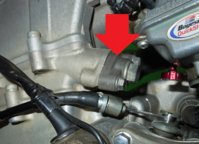
Start by removing the center bolt (12 mm), washer, spring, and rod. Then using a 8mm socket remove the two outer bolts, this will allow you to pull the complete cam chain tensioner body out. (See image below)
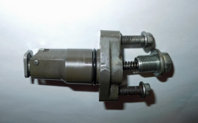
After you have the tensioner removed, it's time to take off the first cam cap. I personally find it easier to removed the cams one-by-one (remove one cam, adjust the valves, replace the first cam, and then move on to the second cam), however you can also remove them both at the same time. Start by removing the four bolts holding the cam cap on, then carefully remove it. Make sure that the dowel locator pins or the cam position ring don't fall into the engine. (Pin magnet works great if this does happen)
Shown with exhaust cam cap removed
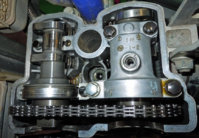
And now one of the more trickier parts, removing the cam.
Lifting up the back of the cam generally gives you a little more slack, so start with that. I usually try to "walk" the chain off by getting all the slack to one place, but whatever you do, DON'T FORCE IT. If you're having issues, try removing both cams at the same time. It's easier to remove them that way but makes it harder to get your timing right later. Also, if the cam chain seems to have a lot of extra slack you should replace it. (Preventative maintenance)
Here's a little trick I came up with, get yourself a shop towel (or paper) and mark it like the image below. This way there's absolutely no guessing as to where something goes later.
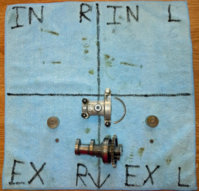
When the cam is finally out, take a piece of wire and tie the cam chain to your frame. This helps prevent the cam chain from slipping off the crank shaft. If that does happen at any point, don't freak out, just take the generator cover off (4 bolts) and put the cam chain back on the sprocket. (See image below)
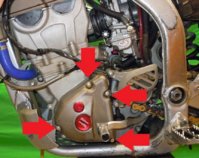
Shown with the cam chain tied to the frame.
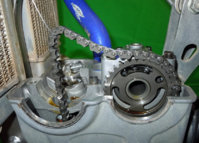
Here you can clearly see the two buckets (tappets), the shims are underneath them.
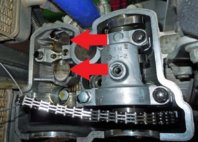
Using the pin magnet pull out the first bucket, the shim is usually stuck to the inside of the bucket, be careful it doesn't drop into the engine.
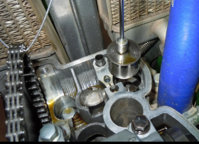
After you've removed the shim, clean it off and measure its thickness with the calipers.
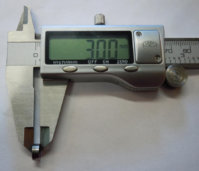
Find the right replacement shim with the following calculation.
A = (B - C) + D
[A] Replacement shim thickness (The shim size you need to re-install to get the correct valve clearance)
[B} Measured valve clearance (The measurement you got in Part 1 with your feeler gauges)
[C] Recommended valve clearance (What your clearance is supposed to be (See below))
[D] Current shim thickness (The shim you just removed from motor)
Recommended Valve Clearance:
A = (.12 - .20) + 3
So it looks like I need a 2.92mm shim, however my shim kit only comes with a 2.90mm & 2.95mm. If this happens go with the smaller shim (2.90mm), unless it takes you out of spec. Always remember that valves typically do not loosen over time and use, they usually tighten up. So shim them to the loose end of the recommended valve clearance range.

Ok so now we know that we need to put a 2.90mm shim back in. Make sure it's the correct size by measuring it with the calipers and then put it back in its little holder. (See image below)
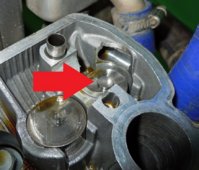
Put the bucket back on.

Continued below...
Since we're starting right where we left off in Part 1, the engine should already be TDC and the cams exposed, if not please read Part 1 first. (Click Here to see Part 1 - Checking Valve Clearances)
Recommended Valve Clearance:
- Intake - .004 to .006 in or .1 to .15mm
- Exhaust - .007 to .009 in or .17 to .22mm
Tools Needed:
- 8 mm socket wrench
- 10 mm socket wrench
- 12 mm socket wrench
- 14 mm socket wrench
- 5/8 spark plug wrench
- Torque wrench
- 6 mm Allen
- Permanent marker
- Flat blade screwdriver (or a quarter)
- Feeler gauges
- Calipers (Digital work the best)
- Pin magnet (not necessary but a headache saver)
- Piece of wire, string, or zip-tie
- Replacement shims

Just to clarify, the below items should already be done (if not refer to Part 1):
- Spark-plug removed
- Valve cover removed
- Timing caps removed
- Engine set to TDC (Top-Dead-Center)

Shown with valve cover off, spark-plug removed, and set to TDC.
Ok now to the "adjusting" part, the first thing I always do is put a ratchet/breaker-bar onto the crankshaft (through the bottom timing hole) and after making sure it's still TDC, zip -tie it to the frame. (See image below) This can save headaches down the road.

Next, using a permanent marker, put a mark across your cam chain and sprocket (use a rag to wipe the oil off before you mark it). This makes the re-install go a lot quicker, all you have to do now is lineup the marks and the engine is correctly timed. (See image below)

After that's done you'll have to remove the cam chain tensioner (see image below), this will relieve the tension on the cams, allowing you to remove them.

Start by removing the center bolt (12 mm), washer, spring, and rod. Then using a 8mm socket remove the two outer bolts, this will allow you to pull the complete cam chain tensioner body out. (See image below)

After you have the tensioner removed, it's time to take off the first cam cap. I personally find it easier to removed the cams one-by-one (remove one cam, adjust the valves, replace the first cam, and then move on to the second cam), however you can also remove them both at the same time. Start by removing the four bolts holding the cam cap on, then carefully remove it. Make sure that the dowel locator pins or the cam position ring don't fall into the engine. (Pin magnet works great if this does happen)
Shown with exhaust cam cap removed

And now one of the more trickier parts, removing the cam.
Lifting up the back of the cam generally gives you a little more slack, so start with that. I usually try to "walk" the chain off by getting all the slack to one place, but whatever you do, DON'T FORCE IT. If you're having issues, try removing both cams at the same time. It's easier to remove them that way but makes it harder to get your timing right later. Also, if the cam chain seems to have a lot of extra slack you should replace it. (Preventative maintenance)
Here's a little trick I came up with, get yourself a shop towel (or paper) and mark it like the image below. This way there's absolutely no guessing as to where something goes later.

When the cam is finally out, take a piece of wire and tie the cam chain to your frame. This helps prevent the cam chain from slipping off the crank shaft. If that does happen at any point, don't freak out, just take the generator cover off (4 bolts) and put the cam chain back on the sprocket. (See image below)

Shown with the cam chain tied to the frame.

Here you can clearly see the two buckets (tappets), the shims are underneath them.

Using the pin magnet pull out the first bucket, the shim is usually stuck to the inside of the bucket, be careful it doesn't drop into the engine.

After you've removed the shim, clean it off and measure its thickness with the calipers.

Find the right replacement shim with the following calculation.
A = (B - C) + D
[A] Replacement shim thickness (The shim size you need to re-install to get the correct valve clearance)
[B} Measured valve clearance (The measurement you got in Part 1 with your feeler gauges)
[C] Recommended valve clearance (What your clearance is supposed to be (See below))
[D] Current shim thickness (The shim you just removed from motor)
Recommended Valve Clearance:
- Intake - .004 to .006 in or .1 to .15mm
- Exhaust - .007 to .009 in or .17 to .22mm
A = (.12 - .20) + 3
So it looks like I need a 2.92mm shim, however my shim kit only comes with a 2.90mm & 2.95mm. If this happens go with the smaller shim (2.90mm), unless it takes you out of spec. Always remember that valves typically do not loosen over time and use, they usually tighten up. So shim them to the loose end of the recommended valve clearance range.

Ok so now we know that we need to put a 2.90mm shim back in. Make sure it's the correct size by measuring it with the calipers and then put it back in its little holder. (See image below)

Put the bucket back on.

Continued below...

